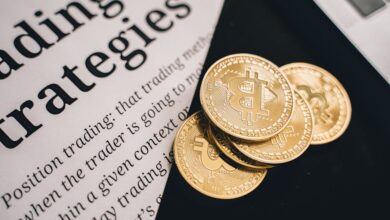The Role of Gold in Forex and Global Trade: Understanding Its Impact on Currency Exchange and Investment Trends

In the intricate landscape of global trade, gold remains a pivotal player, transcending its status as a mere commodity to establish itself as a safe haven asset. As economic uncertainties loom and inflationary pressures rise, investors increasingly turn to gold investment as a reliable store of value. This article delves into the multifaceted role of gold within the forex market and its profound impact on currency exchange rates. From understanding how gold prices influence global markets to analyzing current gold market trends, we will explore the dynamics of gold reserves and the significance of central banks' gold holdings. Additionally, we will examine the future of gold investment, including the rise of gold ETFs, the importance of sustainable gold mining practices, and the emerging relationship between gold and cryptocurrency. Join us as we uncover the complex interplay between gold and global trade, revealing why this timeless metal continues to captivate the financial world.
- 1. Understanding Gold's Impact on Forex: The Safe Haven Asset in Global Trade
- 2. Analyzing Gold Market Trends: How Gold Prices Influence Currency Exchange
- 3. The Future of Gold Investment: Gold Reserves, ETFs, and the Role of Central Banks
1. Understanding Gold's Impact on Forex: The Safe Haven Asset in Global Trade
Gold has long been recognized as a safe haven asset, especially in times of economic uncertainty. Its impact on the foreign exchange (forex) market and global trade cannot be overstated. As investors seek stability, gold often becomes a preferred choice, influencing gold prices and the overall dynamics of the gold market.
When financial markets are volatile, or inflation rises, gold investment typically spikes. Investors consider physical gold, including gold bars and gold coins, as a hedge against currency fluctuations and economic downturns. This behavior directly affects gold market trends, as demand for gold ETFs and gold futures increases, reflecting a broader interest in securing wealth.
Central banks also play a crucial role in the gold trade. They hold significant gold reserves, which serve as a buffer against economic instability. The actions of these institutions can influence gold prices globally. For instance, when central banks increase their gold holdings, it often signals confidence in gold as a reliable asset, further driving up its market value.
Moreover, the rise of gold as a collectible, including luxury gold jewelry and rare gold coins, highlights its multifaceted nature in global trade. Collectibles can not only appreciate in value over time but also serve as a status symbol. This dual role fuels global gold demand, as investors and collectors alike seek to diversify their portfolios.
The sustainability of gold mining practices is increasingly coming into focus. With growing concerns about environmental impact, sustainable gold mining initiatives are gaining traction. This shift not only affects the supply side of the gold market but also aligns with consumer preferences for ethically sourced gold.
In the context of gold and cryptocurrency, there is an emerging dialogue about the complementary roles these assets play in investment strategies. While cryptocurrencies offer a modern alternative, gold remains the traditional safe haven asset, providing a sense of security that digital assets may not yet match.
In conclusion, understanding gold's impact on forex and global trade involves recognizing its status as a safe haven asset. From influencing gold prices to shaping market trends, gold continues to be a pivotal player in the financial landscape. Its physical forms, from gold bullion to coins, coupled with sustainable mining practices, ensure that gold remains a vital component of investment strategies worldwide.
2. Analyzing Gold Market Trends: How Gold Prices Influence Currency Exchange
Understanding gold market trends is crucial for analyzing how gold prices influence currency exchange rates. As a safe haven asset, gold often experiences increased demand during periods of economic uncertainty or inflation. When investors seek stability, they tend to turn to gold, resulting in higher gold prices. This surge can lead to a corresponding decrease in the value of currencies, particularly those of countries with weaker economic fundamentals or high inflation rates.
The relationship between gold and currency exchange is evident in various scenarios. For instance, as central banks accumulate gold reserves, they signal confidence in their economies, which can bolster the value of their currencies. Conversely, when gold prices spike due to heightened global demand, it may indicate that investors are losing faith in fiat currencies, causing those currencies to depreciate against gold.
Moreover, the gold market is influenced by various factors, including gold mining output, gold recycling, and gold technology advancements. The production of gold, particularly through sustainable gold mining practices, plays a significant role in shaping market dynamics. When gold production increases, it can lead to lower prices, impacting currency valuations as well.
Gold ETFs and gold futures also play a pivotal role in the gold market trends. These financial instruments allow investors to gain exposure to gold without holding physical gold, thereby influencing the supply-demand balance. As more investors flock to gold ETFs, the increased demand can drive up gold prices, further impacting currency exchange rates.
In the context of global trade, fluctuations in gold prices can also affect countries that rely heavily on gold exports. Nations with substantial gold reserves or that are significant players in the gold trade may see their currencies strengthen when gold prices rise, benefiting from increased export revenues.
In conclusion, gold prices are not only a barometer of economic stability but also a critical factor in currency exchange. Understanding the intricate relationship between gold market trends and currency valuation is essential for investors, traders, and policymakers alike. By analyzing these trends, one can better navigate the complexities of global finance and make informed decisions regarding gold investments, whether in the form of gold bullion, gold coins investing, or luxury gold collectibles.
3. The Future of Gold Investment: Gold Reserves, ETFs, and the Role of Central Banks
The future of gold investment is shaped by various factors, including global economic conditions, shifting market trends, and the evolving role of gold in the financial system. As investors seek stability amid market volatility, gold continues to be regarded as a safe haven asset. The rising global gold demand, driven by inflationary pressures and geopolitical uncertainties, highlights the enduring appeal of this precious metal.
Gold reserves held by central banks play a crucial role in maintaining economic stability. Central banks often increase their gold holdings to diversify their portfolios and hedge against currency fluctuations. This trend is evident as many central banks have been accumulating physical gold, which is seen as a reliable store of value. In recent years, countries like China and Russia have significantly boosted their gold reserves, reflecting a broader strategy to reduce dependency on the US dollar.
Another growing avenue for gold investment is through gold exchange-traded funds (ETFs). These financial products offer investors an accessible way to gain exposure to gold without the need for physical storage. Gold ETFs have become increasingly popular due to their liquidity and ease of trading. Investors can buy and sell shares that are backed by physical gold, making it an attractive option for those looking to invest in gold without the complexities of gold mining or physical gold ownership.
As technology advances, gold mining and refining processes are becoming more sustainable. The gold industry is increasingly focusing on responsible practices, including sustainable gold mining and gold recycling initiatives. This shift not only meets consumer demand for ethically sourced gold but also addresses environmental concerns associated with gold production. Additionally, the rise of luxury gold products, including gold jewelry and collectibles, continues to drive demand in various markets.
The intersection of gold and cryptocurrency is a developing area of interest for investors. As digital currencies gain traction, the relationship between gold and cryptocurrency may evolve, influencing both the gold market trends and investor behavior. While gold remains a traditional safe haven, cryptocurrencies are often viewed as a speculative asset. Understanding this dynamic is essential for future gold market analysis.
Overall, the future of gold investment will likely be characterized by a blend of traditional practices and modern innovations. Whether through gold bullion, coins, ETFs, or sustainable practices, the role of gold in global trade and finance remains significant, adapting to the changing landscape of the economic environment. Investors should stay informed about gold prices, gold futures, and market trends to navigate this complex yet rewarding asset class effectively.
In conclusion, the multifaceted role of gold in forex and global trade underscores its enduring significance as a safe haven asset. As we have explored, gold not only influences currency exchange rates through its price fluctuations but also serves as a critical component in the portfolios of central banks and investors alike. The ongoing analysis of gold market trends reveals that fluctuations in gold prices can significantly impact global gold demand and, consequently, currency valuations.
Looking ahead, the future of gold investment appears promising, with innovations in gold ETFs and sustainable gold mining practices paving the way for more accessible investment opportunities. The integration of gold technology into production and refining processes, along with the rise of luxury gold collectibles, demonstrates the adaptability of gold in a changing economy. Moreover, as discussions around gold and cryptocurrency evolve, it is clear that gold's position will continue to be pivotal in the financial landscape.
As investors navigate the complexities of gold mining, recycling, and trading, understanding the dynamics of gold reserves and their relationship with inflation will be crucial. Whether through physical gold, gold futures, or gold coins investing, the strategies surrounding gold remain vital for diversifying one’s portfolio and safeguarding wealth. In a world marked by uncertainty, gold will continue to shine as a reliable asset, reflecting its timeless value in global finance.
References:
[Include relevant citations here]




